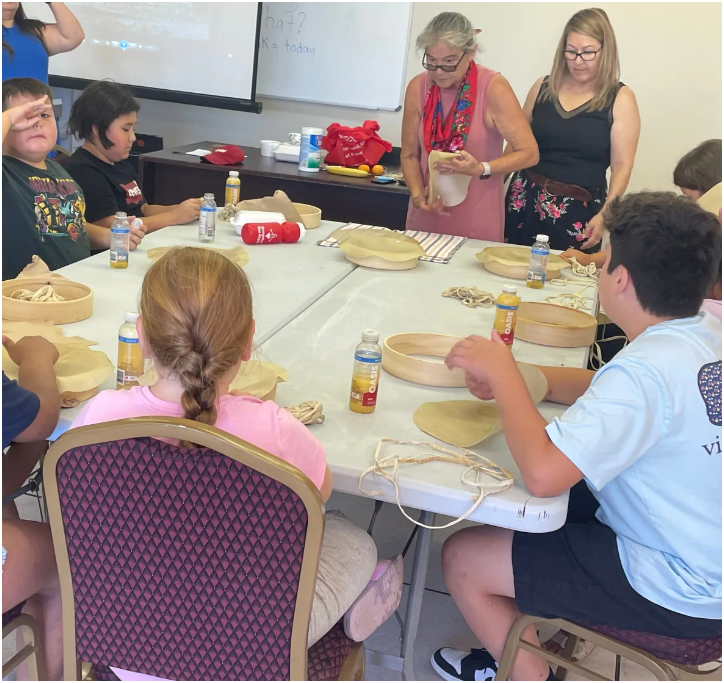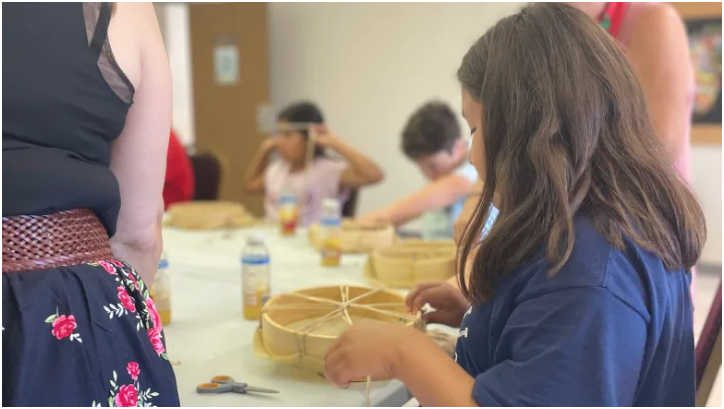Esgenoôpetitj's Karen Somerville was teaching a table of children how to string moose skin through a wooden drum frame when one child started rhythmically banging her hands on the table.
Soon they all joined in, little voices filling the room, singing in Mi'kmaw while stretching the wet moose skins over the frames of the drums.
In the crowd were three generations of camp organizers, including Candida Nickerson and her family. Her son, Damon Nickerson, was learning Mi'kmaw, and her mother was teaching alongside Sommerville.

"I love how engaged the children are. That to me is my favourite part so far. They come in here with the best attitudes, they're so proud of themselves," said Nickerson.
The Esgenoôpetitj immersion camp is for children between the ages of eight and 14, and is part of the Three Nations Education Group's effort to support language learning for First Nations people.
"I've never had to make a drum before, so I'm really excited to make one because I want to bring it home and show my parents. I know they are excited about me making one," said Eldon Cruz Taylor who, at 12, is one of the oldest children in the camp.
His favourite Mi'kmaw word is Wela'lin, which means thank you.
"I guess because I like saying thank you a lot to people, I just show appreciation for what people do for me."
After making their drums, the children headed to the garden outside to see medicinal plants and tobacco. They also watched a fully translated Mi'kmaw version of Chicken Run, which Nickerson said is funnier than the original English version.

Somerville has been teaching Mi'kmaw culture to people of all ages for 20 years, but has focused on teaching the Mi'kmaw language for the last 10 years.
"Seeing the children's eyes when I tell them how one word can mean an entire sentence is my favourite part," she said.
The residential school system tried to assimilate Indigenous children by removing them from their languages and cultures. Nickerson's grandfather was forced to attend a residential school. Her grandmother was forced to attend an Indian day school, and was prohibited from speaking her language at home.
"The schools had taught my grandparents that if they continued speaking to their children, their children wouldn't be successful. But it's the total opposite. It's a part of who we are and we're safe to be who we are. It's up to me ... to learn and to pass it on to my children," she said.
Somerville's mother was a full speaker as well and was hidden during the residential school pickups, so she grew up with the Mi'kmaw language.
"I think when I was about 18 or so, I started hearing it again amongst the community people and I started learning, and made a lot of mistakes," Sommerville said.
Afterwards, Sommerville attended Saint Thomas University where she took the Native Studies Mi'kmaw Language Program with Mildred Milliea, an elder from Elsipogtog.
"I can walk away from this camp knowing that these kids had a great time. They were surrounded by people who love and care for them and that they learned a large part of our culture," she said.
Holly Mitchell grew up in Esgenoôpetitj and dropped by to watch her son at the camp. He goes to an off-reserve French immersion school. Mitchell never got to attend a camp like this, so she wanted him to have a chance to be immersed in the Mi'kmaw culture.
"When I had seen it, I knew I had to sign my son up right away," she said. "That would have helped revitalize the culture in my generation."
Mitchell has never made a drum before, but is glad to know her son is learning how to build one.
Somerville said anyone can learn the language.
"I just want to encourage anyone that has an inkling or anything. Reach out if you want to learn the language. Reach out to our community."
Starting with children is the first step to revitalizing the Mi'kmaw culture, said Nickerson.
"For me, it's extremely important to learn my language. If we can start here with our children, then I'm more than happy to run this camp."







